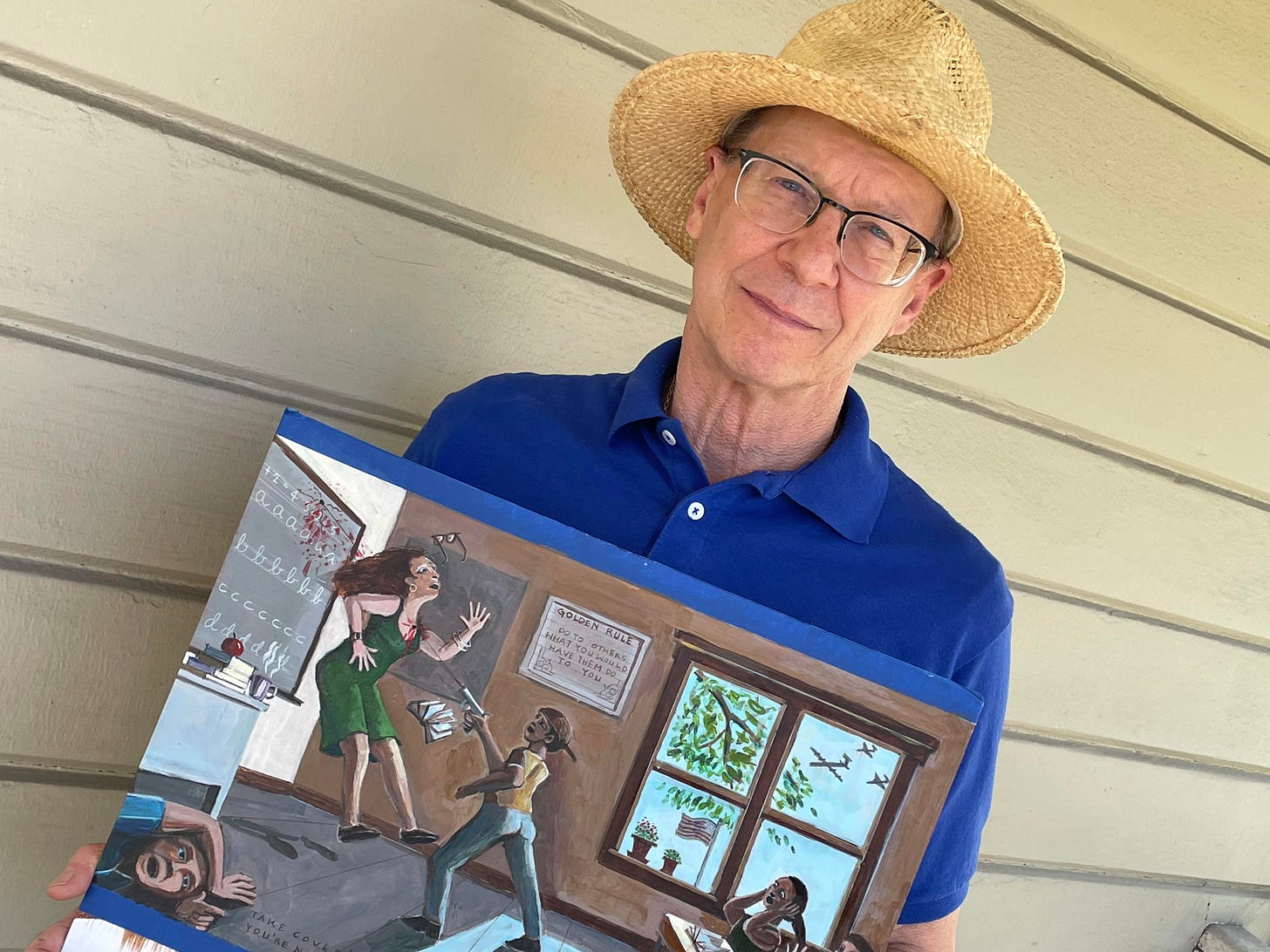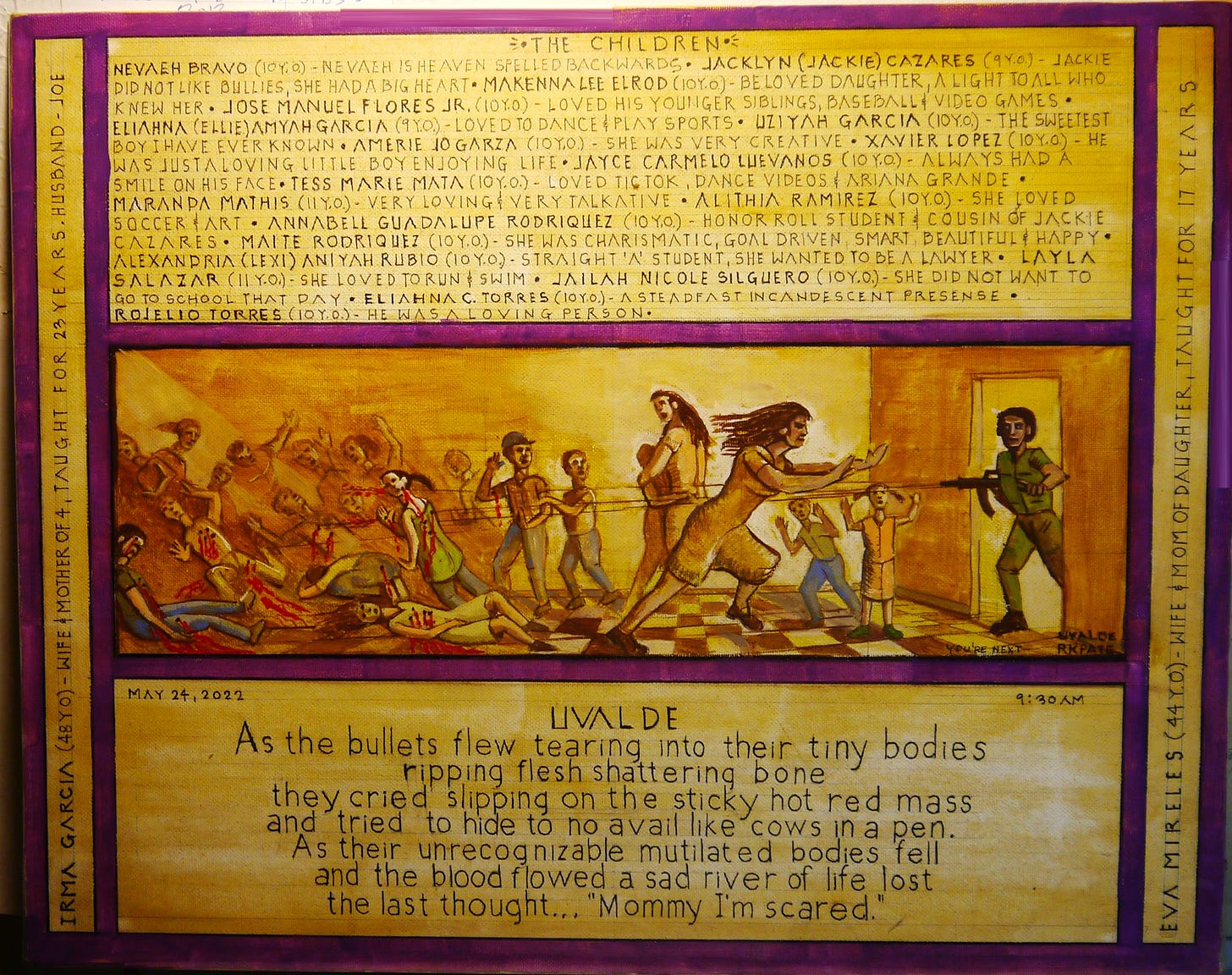Will cranking up the gore result in more sensible gun laws?
A local architect thinks so and has started a facebook group, Mass Shooting Protest Art, in search of art that will change minds
Sebastopol architect Richard Pate has a lot of respect for the transformative power of art and its ability to change minds and shape politics.
Appalled and frustrated by the ongoing plague of mass shootings, he began to wonder how he and others could use art to turn the tide.
“I was trying to figure out ‘Okay, what can I do to try to change people’s minds and figure out a way to get them to agree that sensible gun laws are the way to go?’ And how do we stop this madness? I mean there’s like 250 shootings so far this year, and there’s one or two a day. It’s just nuts,” he said.
Pate is no stranger to guns. He grew up in Texas, spent his youth hunting and fishing, and was a longtime member of the NRA.
“So I began to research, what can I do? And how have people dealt with these kind of things before – these big social issues? And I’m so freakin’ old, I remember watching the civil rights movement in black and white—the Edmund Pettus Bridge—and it had a huge effect on everybody I knew, including my parents who were, up to that point, still part of the Jim Crow generation. But the graphic imagery that we saw every night at dinner time made a huge difference. And then Vietnam came along and the same thing happened. Every night, we watched these incredibly horrific, graphic images while we were eating dinner, and even parents that were conservative started changing their minds.”
He asked himself why the same thing wasn’t happening with the modern problem of mass shootings and he came up with a novel answer—the coverage of these events wasn’t graphic enough.
“In those days, the news basically wasn’t censored. I mean they went out there, and they presented whatever they wanted to. Nowadays because we’re apparently so soft and vulnerable, everything is blurred out, if they show anything at all. Or it’s always introduced by ‘Caution, this could be disturbing.’ And for me, what’s disturbing is that they’re not showing the real thing. It’s a real disservice to not show the horror of this stuff because that’s what’s going to change people’s minds— just like it did in the Civil Rights Movement, just like it did in Vietnam.”
Inspired in part by the Obama hope poster and what an effective piece of political art that was, he started to do paintings about mass shootings.
“I started producing these paintings, and I had the idea of the “You’re next” series. Because I thought ‘Well, that’s right in your face.’ But it’s also real,” he said. “I mean, who knows who is next? So in all my paintings, you’ll find somebody saying, “You’re next.”
And he doesn’t spare the gore: bullets toss people into the air, bodies explode with blood.
He also has a series where he inserts mass shooters into famous works of art.
To disseminate his work and to inspire others to create art against mass shootings, he started a Facebook group called “Mass Shooting Protest Art,” and, frankly, it’s been a hard sell.
“The idea was to create some sort of a venue where any form of expression in regards to protesting mass shootings could be posted—so poetry, prose, pictures, sculpture, paintings, drawings.”
To get things rolling, he posted some of his paintings.
“I was just really kind of disappointed because the most common response I got was people protesting my protest art,” he said. “People couldn’t take it. They said, ‘It’s not going to do any good’ and ‘Why are you showing us this stuff?’”
“But my stuff is tame compared to the reality of the situation—I mean when you have to use DNA to identify the remains of children—it’s just horrific. And I’m like, ‘Well, this is mild compared to that, but it should remind you about how horrible it is.’
“What I figured out is that we all are suffering now from what I call ‘traumatic aversion syndrome.’ And it means we’ve been so exposed to so much of this stuff for so long, with no seeming remedy, it’s like that now we just turn away because it’s so painful it hurts to watch.”
He says he feels that way about those ASPCA commercials about abused animals.
“They’re hard to watch after awhile. It’s an aversion to that trauma. It probably doesn’t even have to happen to you directly; you just have to be exposed to it and have it presented over and over and over and over again. And we all become traumatized. So I think that’s part of the reason that I’m not getting the response that I hoped on the facebook page…I’m not sure that I’m actually achieving what I hoped to achieve,” he said.
But he’s not willing to give up yet.
Pate is hoping to find other artists who are producing mass shooting protest art in hopes of finding that one image that will capture the public’s imagination and turn the political tide – the way that that famous photo of one little girl, covered with napalm, running naked down a road, changed many people’s minds about the war in Vietnam.
“The point is that, okay, well, my stuff’s not that good. I mean, I try hard, but I’m no Michelangelo. The real reason to start the group was to hope to find that person, that artist, who actually can do that piece that’s going to talk to everybody. So in the BLM Movement, it was the MLK in a hoodie, right? In the Me Too movement, it was the pink hat. Big images that get over globally—that’s what I’m looking for. And I’m just trying to fill in the blank until that point.”
You can find his work and the work of others involved in mass shooting protest art on this Facebook page.




Thanks Laura, I appreciate you helping me get the word out. The only thing I would change is the title. Perhaps instead I might have said, "WILL STOPPING THE MEDIA CENSORSHIP & EXPOSING THE REAL HORROR OF MASS SHOOTING result in more sensible gun laws?" "GORE" has too many associations with Tarantino, etc., . Minor point. All in all just what I was hoping for!